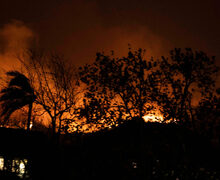Roth: Physical features, areas of residence determine place in Chilean class system
A naked man stood proudly with a zigzagged rainbow painted on his legs. Other painted people — with and without clothes — filled the beach for the Mil Tambores carnival in Valparaíso, Chile. Drum circles started sporadically with the eclectic crowd dancing along.
The naked man and his friends were painting each other on the beach. They circled a banner in the sand that translated to “races of colors.” This made perfect sense when my friend and I were at the festival. In a conversation after we came home, we realized that the phrase didn’t quite work, at least not for Chile.
Chile has, more or less, a homogenous population. Nearly everyone has dark hair, brown eyes and olive-toned skin. However, discrimination called classism is enrooted in Chilean society. Lighter hair and skin indicate a higher class while darker features signify a lower status. This subtle difference in skin tone separates the society into different classes.
Those differing from the appearance of the average Chileans — blonde-haired people or those of Asian or African decent — stick out. Even though blonde people are not that common here, lighter hair and eyes are perceived as more beautiful than the prevalent brown features. Nearly all the women in advertisements are blonde-haired and blue-eyed.
Some perceive indigenous features, such as darker skin, as less beautiful. Last names of indigenous origins are seen as lesser than last names from Spain.
This all had to be explained to me when I first arrived because, as a foreigner, this class system is based on few differences.
But some markers of class are not so subtle. Chile has the greatest difference of income inequality between classes according to the Organization for Economic Cooperation and Development, a forum of 34 countries with strong economies. A large middle class like in the United States doesn’t exist here.
Also, rigid classes don’t mix much in comparison to life in the U.S. Where someone lives marks which side of society they’re on. My host sister said that there are two Santiago’s — the rich side and the poor side. Each municipality’s distinct reputation for wealth, or the lack thereof, feels more extreme than the segregation found in U.S. cities.
The closer a house is to the mountains, the higher its class status, and those of the highest class status live in the hills of the Andes Mountains.
The residents of one of the most elite municipalities, Vitacura, opposed the building of a metro line through the municipality a few years ago. According to my program director, the residents thought a metro would bring in less affluent people and ruin the ambiance of the neighborhood.
This reminded me of a story my mom told me about my hometown of Harrisburg, Pennsylvania. The Walnut Street Bridge connected the city with the suburbs across the Susquehanna River until it broke in two after a blizzard in January of 1996. This river acts as a racial barrier in my hometown.
My mom told me that the residents of the West Shore — nicknamed the “White Shore” — didn’t want this walking bridge rebuilt because they didn’t like that minorities from the city could walk to the suburbs.
Whether it’s called racism or classism, these problems persist in all societies. As a foreigner, the discrimination among classes seems so absurd. When you flip that around to look at the U.S., our system of discrimination based on races is just as horrible.
Maybe we could all take a lesson from the relaxed carnival-goers I met in Valparaíso. Stripped down to the skin, we’re just human.
But I think we should still opt to wear clothes.
Danielle Roth is a junior majoring in magazine journalism and international relations. She is following her desires for good food and adventure in Santiago, Chile. Email her at dlroth@syr.edu or tweet at her @danielleroth_.
Published on October 7, 2014 at 12:01 am





